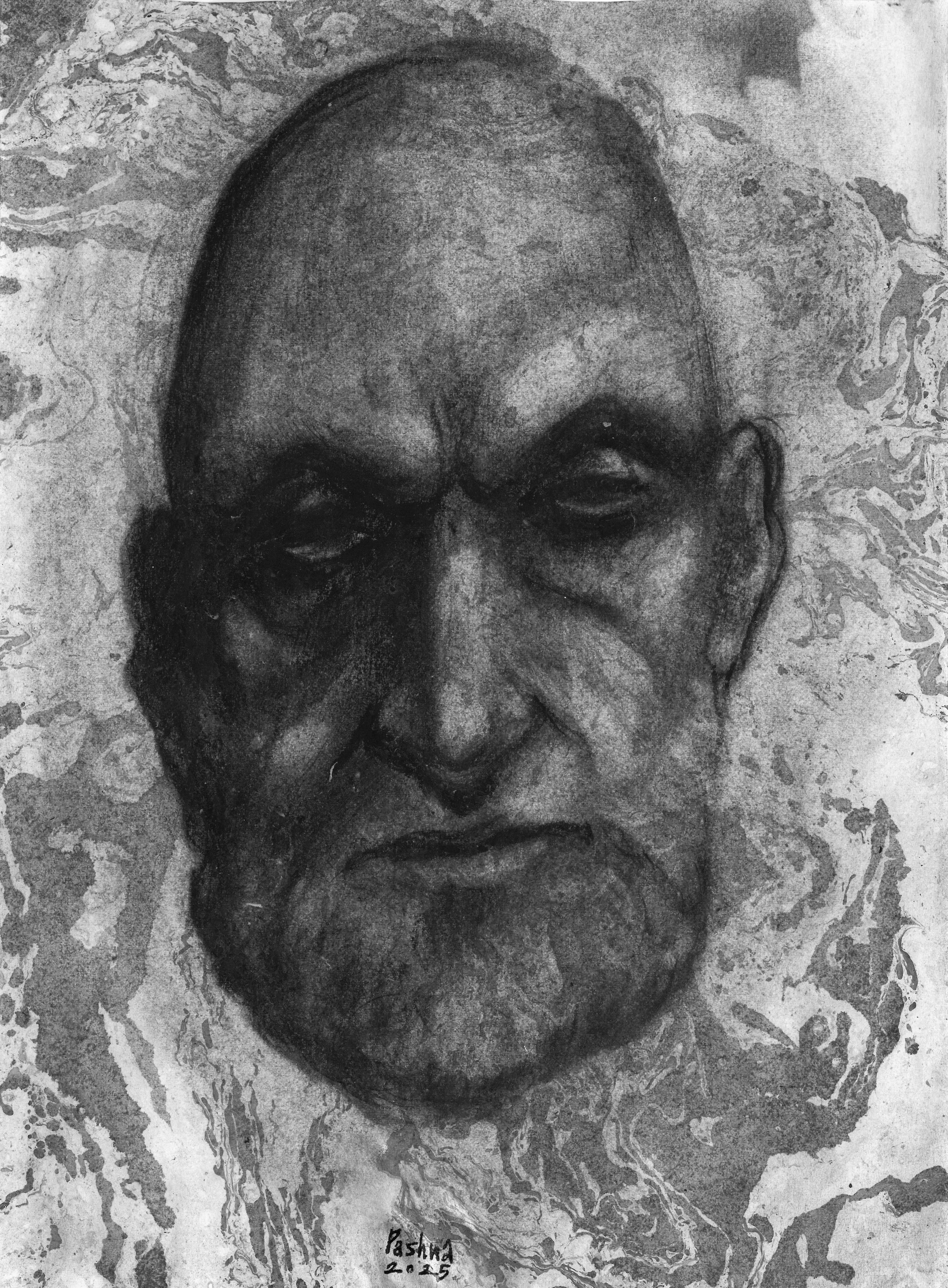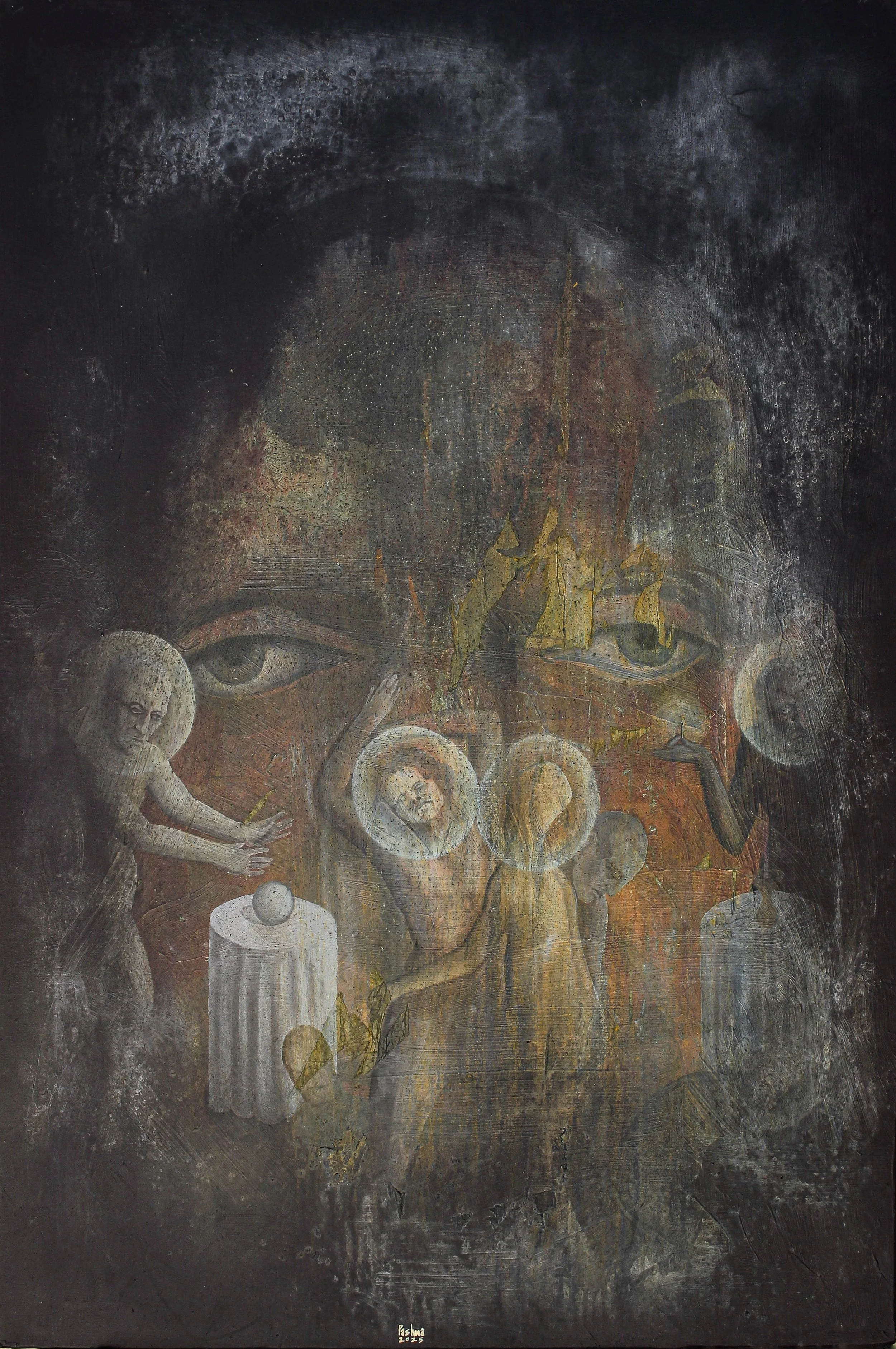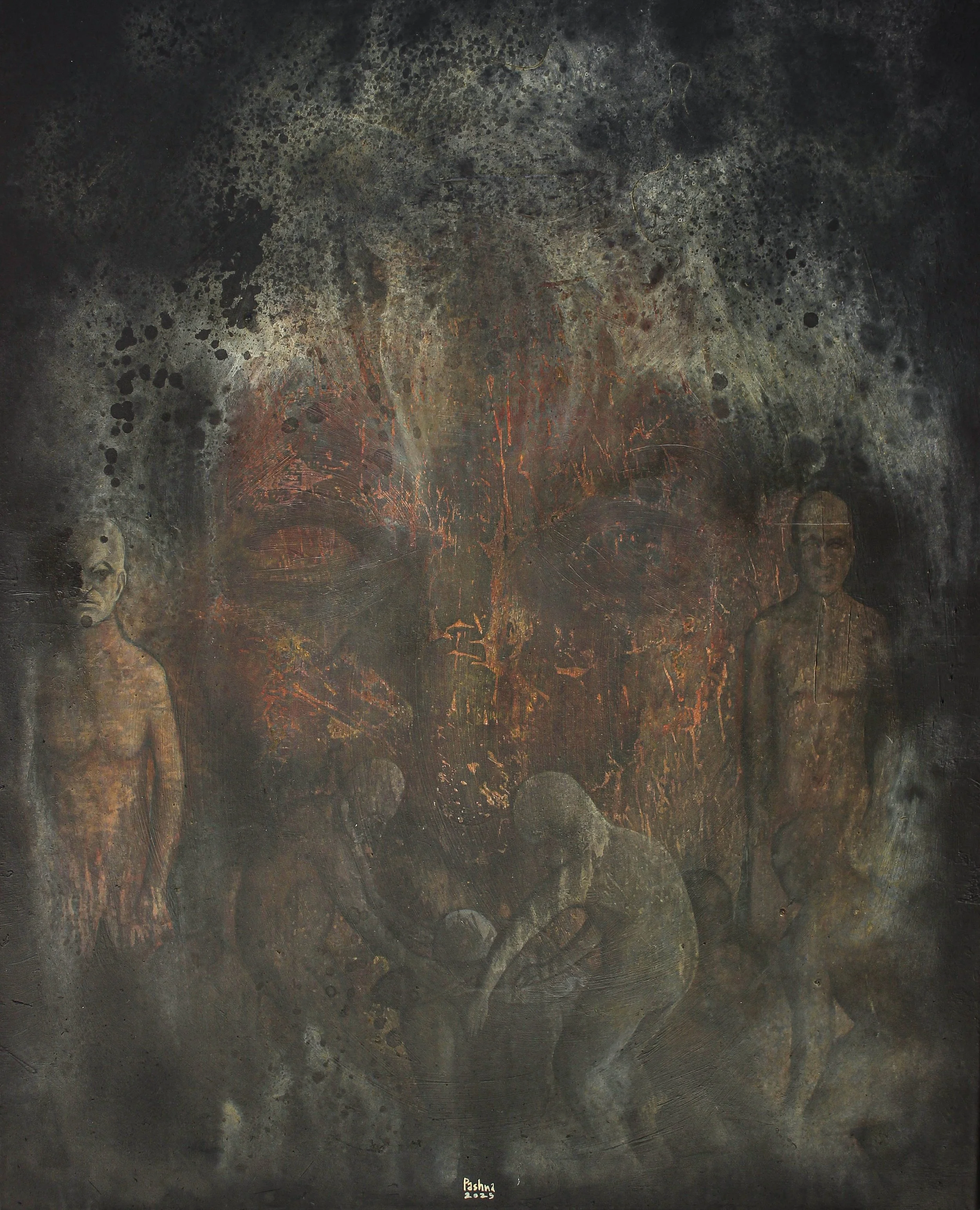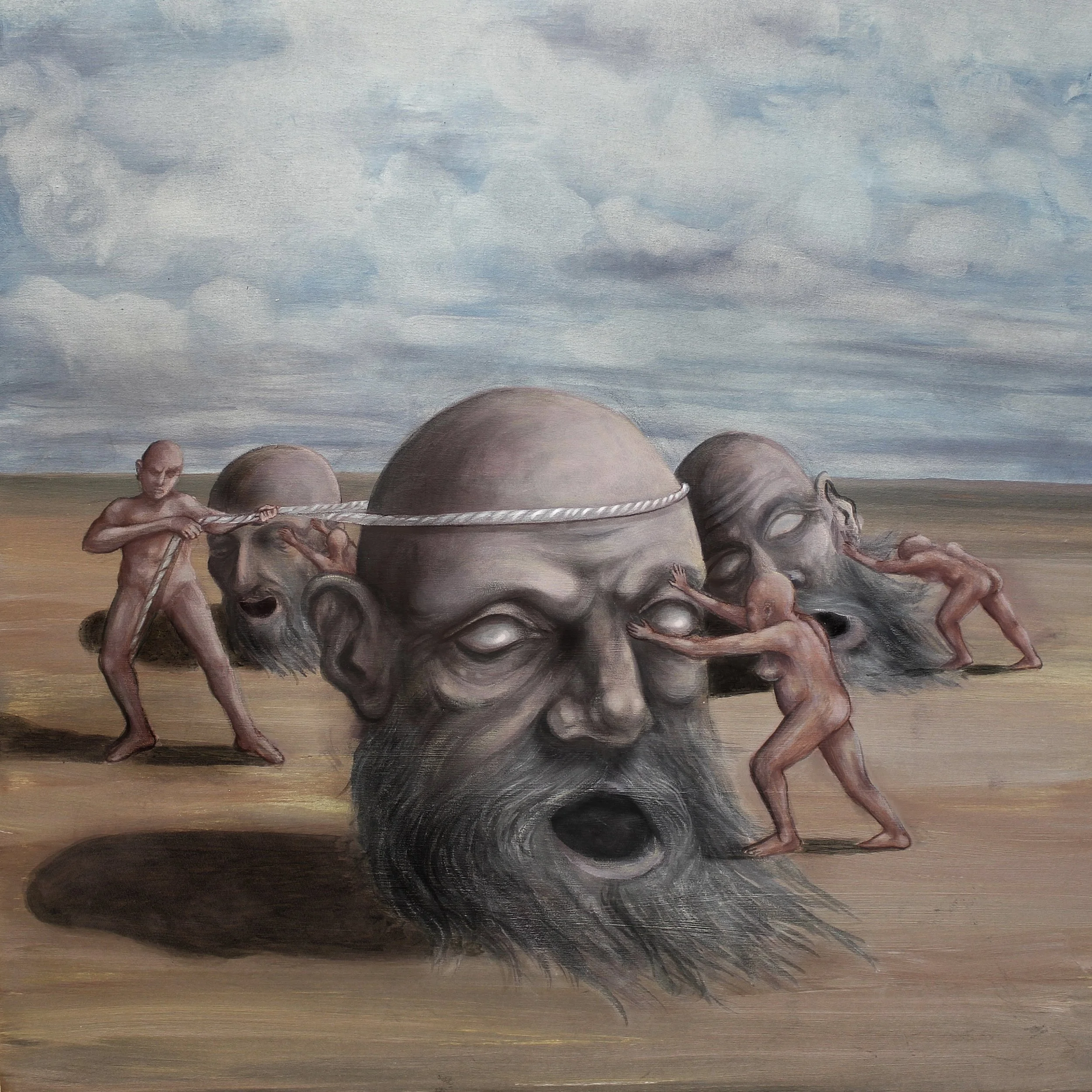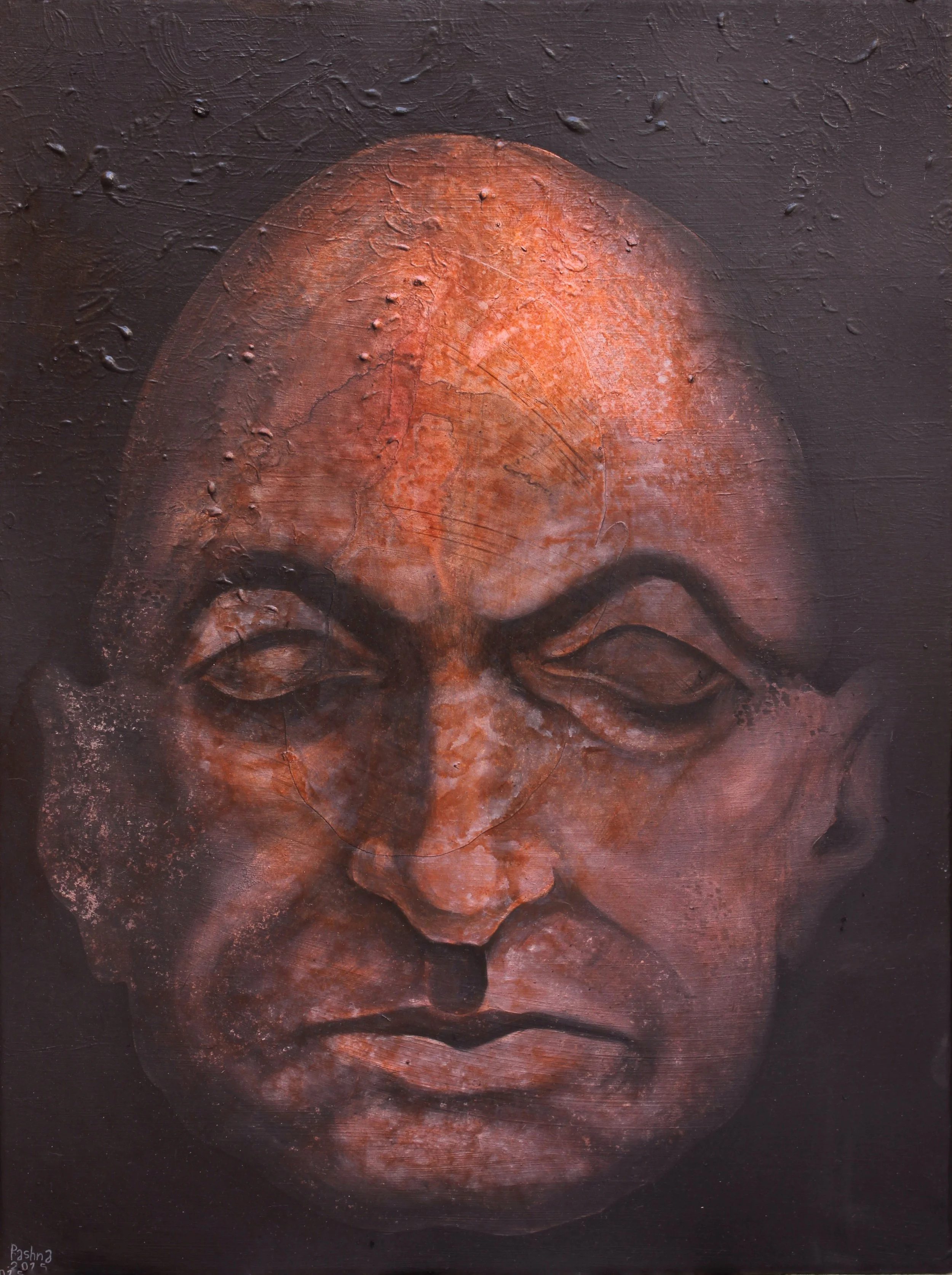In the Gray: Abolfazl Pashna on Darkness, Intention, and Becoming
By Cansu Waldron
Abolfazl Pashna is a painter whose work explores human-centered, philosophical, and existential themes. After earning a diploma in Visual Arts and a Bachelor’s degree in Painting from Azad University, he began exhibiting professionally in 2016. Since then, his practice has evolved from abstract, intuitive explorations of imaginary worlds into works grounded in personal and social realities. His paintings often challenge viewers through the interplay of materials, textures, and layered visual narratives, balancing experimentation with deliberate conceptual intent.
Abolfazl’s work carries a dark yet contemplative tone, reflecting a deep engagement with introspection and existential questioning shaped by his upbringing in the Middle East. He uses muted grays and subdued colors to create spaces where light, form, and meaning emerge gradually, inviting audiences to look closer and discover hidden details. His paintings explore how intentionality and philosophical reflection can transform visual experience into a space for thought and emotional resonance.
We asked Abolfazl about his art, creative process, and inspirations.
You began your professional art journey in 2016 — how has your practice evolved since those early years?
In the beginning, my approach was more abstract and intuitive. I was exploring imaginary beings and alternate worlds within textures and material experiments. Those works had no message or conceptual intention — visually seductive, but ultimately empty, leading to a kind of void.
Over time, I realized that technique and form are meaningful only when they serve an idea. I needed a more grounded, realistic gaze. In other words, I decided to speak through painting, not just produce surfaces.
My focus shifted toward themes rooted in my life and what was happening around me. Material experimentation and accidents (the interaction of materials) became only a part of the work — not the whole purpose. The artist can get lost inside the “accident,” imitating the process rather than guiding it. I wanted to move beyond that and let intention shape the work.
Your works are described as human-centered with a philosophical and dark tone. What draws you to these emotional and existential themes?
It depends on whether “darkness” holds the same meaning for all of us.
For me, darkness is a space where light is born. If you stay in darkness for a few minutes, your pupils begin to dilate, trying to absorb as much light as possible. People say, “your eyes get used to the dark.”
Now imagine if that same mechanism could happen in painting.
In darkness, things are concealed — but if you look long enough, you start to see what others can’t.
Honestly, I use gray, muted, almost dead tones because they satisfy something inside me. Even when I use sharp or vibrant colors, I try to cover them, hide them within texture.
The philosophical dimension feels inevitable. Growing up in the Middle East, introspection and existential questioning are unavoidable. A deeper, spiritual way of seeing the world is the simplest gift that history gives to people from that region.
The idea of “confusion and intertwining” seems central to your work. What does this tension represent for you?
The “center” is exactly where the event is happening — but it remains vague, foggy, unresolved.
Confusion, for me, is the intertwining of subject, texture, and color. A space where everything occurs accidentally, secretly, and almost suffocatingly.
It is not always tension. Sometimes it becomes mourning, sometimes a dance, sometimes loneliness or fear.
By intertwining, I mean the merging of the artwork with daily life. The process can become long and fluid, because the work changes as my emotional state changes. During a nine-month creation process, I allowed the painting to shift with me. The final result was completely different from what I documented at every stage.
You’ve participated in major events like NFT New York and Art Fair Istanbul. How do you see digital art and new media changing the way we experience or value art?
The works I presented in those two events had completely different experiences.
At Art Fair Istanbul, I created hand-painted ceramic pieces using an underglaze technique — they were physical, fragile, and tied to material reality. At NFT New York, the work existed as a digital version of one of my paintings — revealed on a monitor rather than through touch.
The lifespan of a digital piece on the blockchain is potentially infinite — as long as the chain exists, the work exists. A physical piece, however, is mortal: it can break, fade, or disappear. Yet, the value of the physical version remains undeniable.
For me, NFTs function mainly as a certificate of authenticity — a document that protects the origin of the artwork. As a painter, I can explore creative possibilities through digital formats, but I will always return to the canvas, to materials, to holding a brush.
New media is attempting to build a space for independent artists and a more active community — a system where artists can present their work without intermediaries, and where sales and exchanges can occur directly.
Regarding value: I may not know exactly how digital art valuation works, but I do understand how a JPG file can suddenly be worth millions. Web3 still feels like an unknown territory — similar to the early days of the internet, when no one imagined what could eventually be done with it.
The economy of digital art and physical art feels separate. A digital version of a painting must exist for a purpose, and sometimes the valuation of the digital and the physical are completely disconnected.
Digital spaces also follow different aesthetics, sometimes moving toward mass appeal. I used to fall into that trap — worrying about “what sells right now.” That is no longer my concern. I am committed to my own path, while exploring what Web3 can offer without allowing it to dictate the direction of my work.
When your work was selected among 107 New Media Artists in France, what did that recognition mean to you personally and professionally?
The event was structured so that only three artists would be selected by the jury for a residency in France. That was my main motivation, and I did not receive it. However, as the first edition of this event organized by the AFA Annual Awards, a book featuring all the selected works was published — and it was even added to the National Library of France.
Professionally, the experience of hearing feedback from international experts about my work was incredibly valuable. It provided a positive impact and certainly contributed to my growth and progression as an artist.
Do you see a connection between your painting background and your newer explorations in digital and new media art?
It’s hard to predict, because sometimes I create digital paintings with the potential to be animated, and occasionally I even compose music for some of them, creating a multi-dimensional connection. However, I feel they haven’t matured enough yet to be presented publicly.
What directions or themes are you currently exploring in your latest works?
In addition to painting, which remains an inseparable part of my practice, I am currently creating ceramic portraits. These may eventually be presented in a gallery as an integrated installation of sculptures and paintings. The ceramic portraits are finished with volcanic glaze, resembling skull-less heads or human masks. However, the material itself is very important to me, and I plan to provide a more detailed explanation during the exhibition about their connection to my paintings and their own inherent nature.
What is a profound childhood memory?
I think this is the clearest, and perhaps the first, memory that was truly imprinted in my mind — I must have been around three or four years old.
We were living in my grandmother’s house, in an apartment upstairs. One very early morning, I woke up to find sunlight streaming beautifully and evenly across the room. My mother was still asleep, and curiosity got the better of me. I remember finding a rouge and beginning to scribble on the mirror. Soon, the walls and even the stairs leading down to my grandmother’s room were covered in red marks.
This is the first “slap” I remember — a mixture of pleasure and pain. It taught me, early on, that joy and suffering are always intertwined.
What is a fun fact about you?
My spouse and I are on the verge of moving abroad, and we will most likely be settling in France in the coming months. This is the most exciting event I am eagerly anticipating in my life right now.



